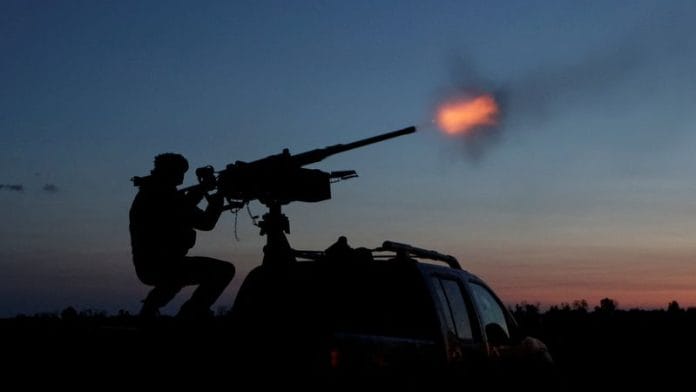Thank you dear subscribers, we are overwhelmed with your response.
Your Turn is a unique section from ThePrint featuring points of view from its subscribers. If you are a subscriber, have a point of view, please send it to us. If not, do subscribe here: https://theprint.in/
The world today stands at a precarious crossroads, where the tremors of past global conflicts—especially World War I and World War II—echo ominously through rising alliances, territorial ambitions, and regional flashpoints. The current global landscape in mid-2025 does resemble a multi-theatre, high-intensity global conflict environment, perhaps unlike any since 1945.
The Past
World War I began in 1914 due to rising nationalism, militarism, imperial rivalries, and a rigid alliance system. Germany’s unification in 1871 disrupted the European balance of power, leading to two major blocs: the Triple Alliance (Germany, Austria-Hungary, Italy) and the Triple Entente (France, Russia, Britain).
World War II arose from unresolved tensions and Axis aggression. The Treaty of Versailles fueled German resentment. The 1930s Depression enabled fascist regimes. Rearmament, League of Nations’ failure, and appeasement led to expansion—Germany in Europe, Italy in Africa and Japan in Asia. The Nazi-Soviet Pact preceded Germany’s 1939 Poland invasion, triggering war. Japan’s 1941 Pearl Harbour attack drew in the U.S.
The Present
Russia’s war in Ukraine, backed by China, North Korea, and Iran, threatens NATO, raising fears of escalation if a NATO state is attacked. China’s push to reclaim Taiwan by 2027 risks direct US-China confrontation, while North Korea escalates with its nuclear navy. Ongoing conflicts in Gaza, Lebanon, and Yemen—along with increased Israeli and UK operations— add to instability. As alliances harden and militaries rearm, experts warn the world may be heading towards a catastrophic war. Global instability goes further, with India-Pakistan tensions under Operation Sindoor, civil wars in Sudan and Myanmar, ongoing conflict in Congo and Ethiopia, gang-controlled Haiti, and a violent drug war in Mexico.
Israel has dropped around 70,000 tons of bombs on Gaza—more than in World War II. Iran is gaining influence via proxies and nuclear goals. A clash with Iran and its proxies could quickly pull in neighboring countries. Like the League of Nations, the UN has failed to stop major wars.
NATO and the Russia–Ukraine War
NATO’s sustained military aid to Ukraine remains crucial but carries risk of triggering a larger confrontation with Russia. Should NATO forces become directly involved, the war could expand rapidly into other European countries. Russia’s continued aggression, if successful in Ukraine, might embolden it to target neighbouring nations such as Poland—whose extensive support for Ukraine makes it a likely next target. Such moves could invoke NATO’s collective defence mechanism, significantly raising the risk of a pan-European or even global war.
Possible Global Fallout
Israel Launched Operation ‘Rising Lion’ on 13 June 2025, a massive retaliatory strike against Iran following a series of provocations. 200 Israeli fighter jets participated in the operation overnight, striking approximately 100 high-value targets. The strike marks one of the most extensive aerial operations in recent history. In response, Iran unleashed a swarm of nearly 100 drones, targeting key Israeli sites and triggering a red alert across the nation.
Just nine days after operation ‘Rising Lion’, U.S. conducted direct airstrikes on 22 June 2025, targeting Iran’s nuclear facilities at Fordow, Natanz, and Isfahan using B-2 Spirit bombers and GBU-57 bunker-buster bombs. Iran’s nuclear enrichment program appears to have been critically crippled. The immediate question now is: Could this escalating confrontation between the U.S., Israel, and Iran ignite a larger global conflict — perhaps even World War III?
While concerns are valid, a wider war remains unlikely for now. Russia is tied up in Ukraine, limiting its capacity. China won’t risk its economic stability and India favors de-escalation due to oil and regional impacts.
More concerning is the silence from major Middle Eastern powers. Despite talk of sovereignty, they remain quiet. Iran may find itself increasingly isolated — the “next Ukraine” on the global chessboard.
De-escalating Global Conflicts: India’s Role as Vishwaguru
The world today is engulfed in multiple conflicts—from Middle East to Eastern Europe, from Africa to Asia. Yet, the five permanent members of the United Nations Security Council (UNSC), entrusted with maintaining global peace, remain disturbingly silent or complicit. Their strategic interests have taken precedence over humanity.
In this global vacuum of moral leadership, India must rise to play the role of Vishwaguru—the voice of reason and restraint. Despite not being a permanent member of the UNSC, India enjoys global credibility, historical neutrality, and a rich civilizational ethos rooted in peace and dialogue. It must now appeal to all warring nations to cease hostilities before these regional fires merge into a global inferno.
India’s call for peace must not be timid diplomacy, but a bold humanitarian appeal to prevent a catastrophe that could spiral into WWIII. The time to act is now—before it is too late.
Col Mohinder Pal Singh, PhD is Director EGROW Foundation. The ideas expressed in the article are personal.
These pieces are being published as they have been received – they have not been edited/fact-checked by ThePrint.



the article is too good, it shows the condition of hole World. thanks you sir for the great thoughts.
Rightly said Sir
U are very inspirational sir ur daily updates help me to stay updated
Excellently explained and covered the entire past, and present scenario in a very beautiful manner.
Thank you sir
Grateful for your analysis of the article
Very helpful sir. Also the NATO has told its member countries to spend huge in defence so this can be seen as a potential threat for countries like Russia, China.
Very insightful sir I got to revise the news which I read in last few days?